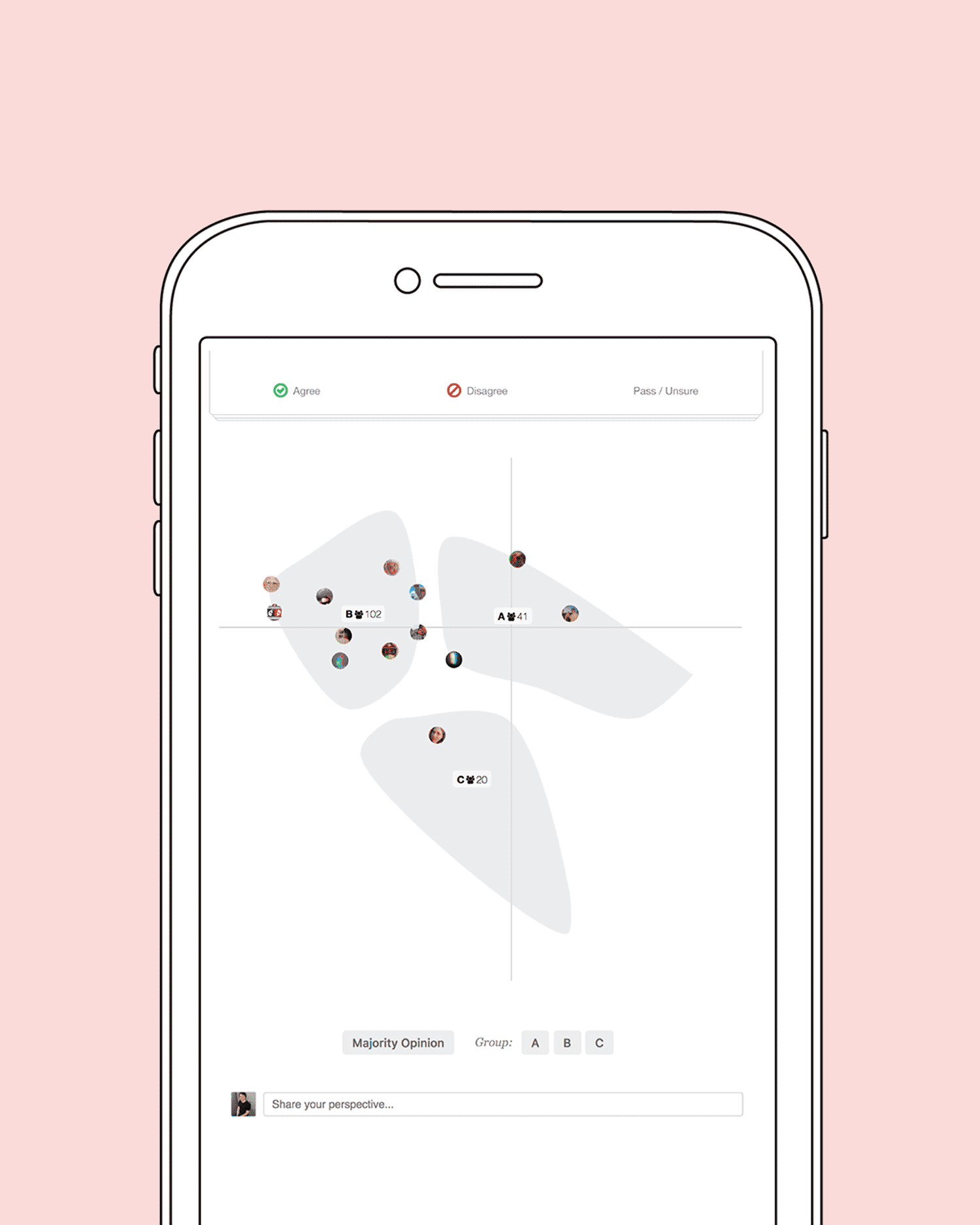The Internet Doesn’t Have to Be Bad for Democracy

Accusations that the Internet and social media sow political division have flown thick and fast since recent contentious elections in the United States, the United Kingdom, and France. Facebook founder and CEO Mark Zuckerberg has even pledged to start working on technology that will turn the energy of online interactions into a more positive force (see “We Need More Alternatives to Facebook”).
Tiny, largely self-funded U.S. startup Pol.is has been working on a similar project longer than Zuckerberg and already has some promising results. The company’s interactive, crowdsourced survey tool can be used to generate maps of public opinion that help citizens, governments, and legislators discover the nuances of agreement and disagreement on contentious issues that exist. In 2016, that information helped the government of Taiwan break a six-year deadlock over how to regulate online alcohol sales, caused by entrenched, opposing views among citizens on what rules should apply.
“It allowed different sides to gradually see that they share the same underlying concern despite superficial disagreements,” says Audrey Tang, Taiwan’s digital minister. The island’s government now routinely sends out Pol.is surveys using Facebook ads, and to special-interest groups. It has also used the system to help thrash out what rules should apply to Airbnb rentals and mobile ride-hailing services such as Uber.
Pol.is’s open-source software is designed to serve up interactive online surveys around a particular issue. People are shown a series of short statements about aspects of a broader issue—for example, “Uber drivers should need the same licenses cab drivers do”—and asked to click to signal that they agree or disagree. People can contribute new statements of their own for others to respond to. The tangle of crisscrossing responses is used to automatically generate charts that map out different clusters of opinion, making it easy to see the points on which people tend to overlap or disagree.
Colin Megill, cofounder and CEO of Pol.is, claims this approach gives governments and parties a better chance of understanding what people really care about than does soliciting avalanches of social media posts or e-mail comments. “This is a problem for lawmakers across the world right now,” he says. “We can help them understand what the electorate is feeling.”
Alternativet, a progressive Danish political party with nine members of parliament, is piloting Pol.is as a way to give its members a more direct role in formulating policy. Jon Skjerning-Rasmussen, a senior process coordinator with the party, says the way Pol.is visualizations are shared with people as they participate in a survey—letting them see how their opinions compare with those of others—helps people engage with the tool.
“Normal polling asks the user to contribute, but rarely gives something back,” he says. One upshot of Alternativet’s trial of the tool has been a rethink of the party’s approach to the idea of a universal basic income. Pol.is revealed that party insiders formed an enthusiastic cluster around the idea that was isolated from the more cautious feelings of the wider membership.
Megill is hopeful Pol.is will soon get a tryout in the United States, citing ongoing talks at federal and state government levels.
Graham Smith, director of the Centre for the Study of Democracy at the University of Westminster, in London, praises the way Pol.is’s design gets people to engage with ideas in a more substantive way than is possible on the commercial services that dominate online life.
“A lot of organizations are using Twitter and Facebook to try and engage publics, but these are not tools or platforms designed with democratic ideals in mind,” he says. Smith is working on a project that will test Pol.is as a way to improve discussions on online news articles.
Still, more tests and case studies are needed to prove how and where the tools can be helpful (or not), says Smith. And like any system put on the Internet, the Pol.is platform will have to stand up to attempts to subvert or break it as it scales up, whether from political pressure groups or mischief-makers. Megill says Pol.is visualizations make astroturfing very obvious by revealing when many people put forth identical views—but the openness of that data could also help attempts to more covertly influence the picture it paints. Political hacks and Internet trolls are nothing if not innovative.
Deep Dive
Policy
Is there anything more fascinating than a hidden world?
Some hidden worlds--whether in space, deep in the ocean, or in the form of waves or microbes--remain stubbornly unseen. Here's how technology is being used to reveal them.
A brief, weird history of brainwashing
L. Ron Hubbard, Operation Midnight Climax, and stochastic terrorism—the race for mind control changed America forever.
What Luddites can teach us about resisting an automated future
Opposing technology isn’t antithetical to progress.
Africa’s push to regulate AI starts now
AI is expanding across the continent and new policies are taking shape. But poor digital infrastructure and regulatory bottlenecks could slow adoption.
Stay connected
Get the latest updates from
MIT Technology Review
Discover special offers, top stories, upcoming events, and more.